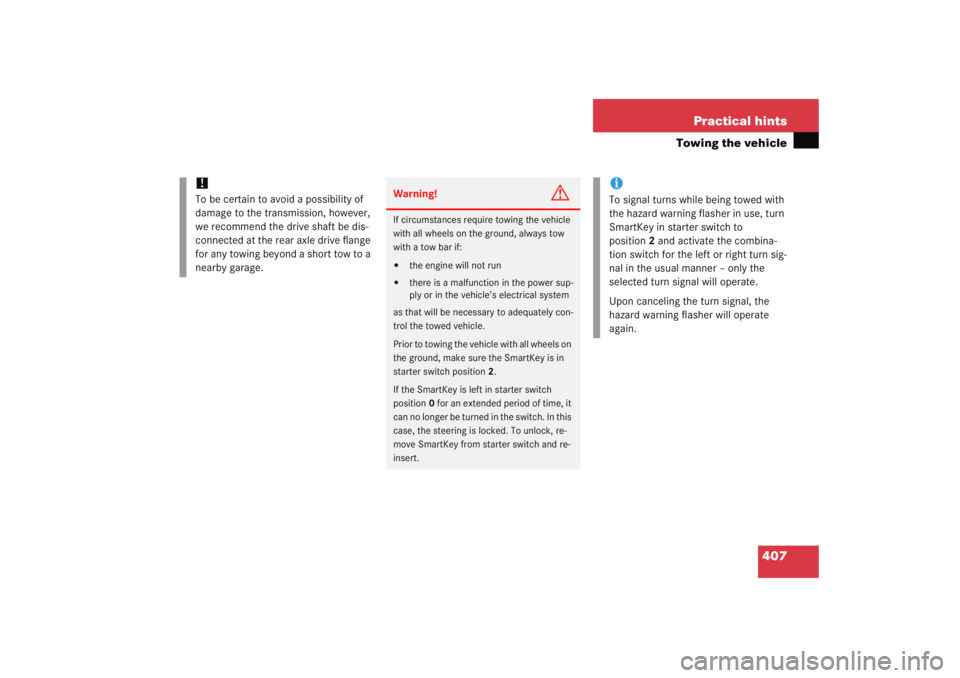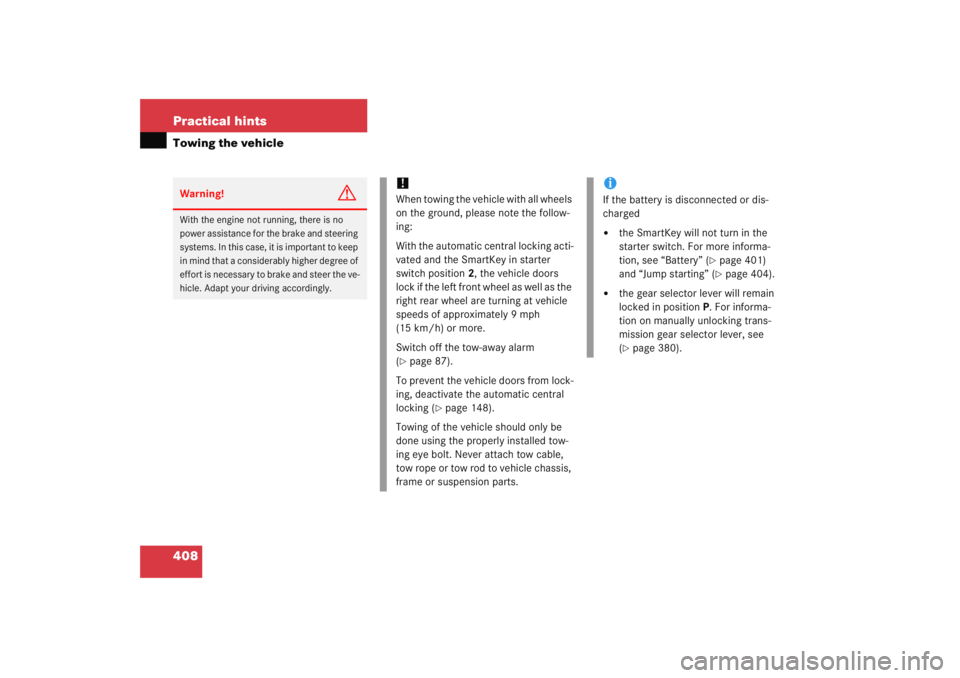Page 408 of 474

407
Practical hints
Towing the vehicle
!
To be certain to avoid a possibility of
damage to the transmission, however,
we recommend the drive shaft be dis-
connected at the rear axle drive flange
for any towing beyond a short tow to a
nearby garage.
Warning!
G
If circumstances require towing the vehicle
with all wheels on the ground, always tow
with a tow bar if:�
the engine will not run
�
there is a malfunction in the power sup-
ply or in the vehicle’s electrical system
as that will be necessary to adequately con-
trol the towed vehicle.
Prior to towing the vehicle with all wheels on
the ground, make sure the SmartKey is in
starter switch position 2.
If the SmartKey is left in starter switch
position 0 for an extended period of time, it
can no longer be turned in the switch. In this
case, the steering is locked. To unlock, re-
move SmartKey from starter switch and re-
insert.
iTo signal turns while being towed with
the hazard warning flasher in use, turn
SmartKey in starter switch to
position 2 and activate the combina-
tion switch for the left or right turn sig-
nal in the usual manner – only the
selected turn signal will operate.
Upon canceling the turn signal, the
hazard warning flasher will operate
again.
Page 409 of 474

408 Practical hintsTowing the vehicleWarning!
G
With the engine not running, there is no
power assistance for the brake and steering
systems. In this case, it is important to keep
in mind that a considerably higher degree of
effort is necessary to brake and steer the ve-
hicle. Adapt your driving accordingly.
!When towing the vehicle with all wheels
on the ground, please note the follow-
ing:
With the automatic central locking acti-
vated and the SmartKey in starter
switch position2, the vehicle doors
lock if the left front wheel as well as the
right rear wheel are turning at vehicle
speeds of approximately 9 mph
(15 km/h) or more.
Switch off the tow-away alarm
(�page 87).
To prevent the vehicle doors from lock-
ing, deactivate the automatic central
locking (
�page 148).
Towing of the vehicle should only be
done using the properly installed tow-
ing eye bolt. Never attach tow cable,
tow rope or tow rod to vehicle chassis,
frame or suspension parts.
iIf the battery is disconnected or dis-
charged�
the SmartKey will not turn in the
starter switch. For more informa-
tion, see “Battery” (
�page 401)
and “Jump starting” (�page 404).
�
the gear selector lever will remain
locked in position P. For informa-
tion on manually unlocking trans-
mission gear selector lever, see
(�page 380).
Page 418 of 474
417
Technical data
Layout of poly-V-belt drive
� Layout of poly-V-belt drive
C230Kompressor
1 Power steering pump
2 Idler pulley
3 Supercharger
4 Automatic belt tensioner
5 Air conditioning compressor
6 Crankshaft
7 Coolant pump
8 Generator (alternator)
C320
1 Automatic belt tensioner
2 Power steering pump
3 Air conditioning compressor
4 Crankshaft
5 Coolant pump
6 Generator (alternator)
7 Idler pulley
Page 427 of 474
426 Technical dataFuels, coolants, lubricants, etc.CapacitiesVehicle components and their respective
lubricants must match. Therefore use only
brands tested and approved by
Mercedes-Benz. Please refer to the Factory Approved Service Products
pamphlet, or inquire at your authorized
Mercedes-Benz Center.
Model
Capacity
Fuels, coolants, lubricants, etc.
Engine with oil filter
C230Kompressor
C320
5.8 US qt (5.5 l)
7.9 US qt (7.5 l)
approved engine oils
Automatic transmission
8.5 US qt (8.0 l)
MB Automatic Transmission Fluid
Manual transmission
1.3 US qt (1.2 l)
MB Manual Transmission Oil
Rear axle
1.2 US qt (1.1 l)
Hypoid gear oil SAE 85 W 90
Power steering
approx. 1.1 US qt (1.0 l)
MB Power Steering Fluid (Pentosin CHF 11S)
Front wheel hubs
approx. 2.1 oz (60 g) each
High temperature roller bearing grease
Cooling system
C230Kompressor
C320
approx. 5.9 US qt (5.6 l)
approx. 6.8 US qt (6.4 l)
MB 325.0 Anticorrosion/Antifreeze Agent
Page 439 of 474

438 Technical termsControl systemThe control system is used to call up
vehicle information and to change
component settings. Information and
messages appear in the multifunction
display. The driver uses the buttons on
the multifunction steering wheel to
navigate through the system and to ad-
just settings.
Cruise control Driving convenience system for auto-
matically maintaining the vehicle speed
set by the driver.
Curb weight (
�page 323)
DOT (Department o
f Transportation)
(
�page 323)
Engine number The number set by the manufacturer
and placed on the cylinder block to
uniquely identify each engine pro-
duced. Engine oil viscosity
Measurement for the inner friction (vis-
cosity) of the oil at different tempera-
tures. The higher the temperature an
oil can tolerate without becoming thin,
or the lower the temperature it can tol-
erate without becoming viscous, the
better the viscosity.
ESP (E
lectronic S
tability Pr
ogram)
Improves vehicle handling and direc-
tional stability.
ETD (E
mergency T
ensioning D
evice)
Device which deploys in certain frontal
and rear collisions exceeding the sys-
tem's threshold to tighten the seat
belts.
->SRS FSS (Canada vehicles)
(F
lexible S
ervice S
ystem)
Maintenance service indicator in the
multifunction display that informs the
driver when the next vehicle mainte-
nance service is due. FSS evaluates
engine temperature, oil level, vehicle
speed, engine speed, distance driven
and the time elapsed since your last
maintenance service, and calls for the
next maintenance service accordingly.
GAWR (G
ross A
xle W
eight R
ating)
(
�page 323)
Gear range Number of gears which are available to
the automatic transmission for shifting.
The automatic gear shifting process
can be adapted to specific operating
conditions using the gear selector le-
ver.
Page 440 of 474

439
Technical terms
GPS*
(G
lobal P
ositioning S
ystem)
Satellite-based system for relaying
geographic location information to and
from vehicles equipped with special re-
ceivers. Employs CD digital maps for
navigation.
GVW (G
ross V
ehicle W
eight)
(
�page 324)
GVWR (Gross V
ehicle W
eight R
ating)
(
�page 324)
Instrument cluster The displays and indicator/warning
lamps in the driver’s field of vision, in-
cluding the tachometer, speedometer
and fuel gauge. Kickdown
Depressing the accelerator past the
point of resistance shifts the transmis-
sion down to the lowest possible gear.
This very quickly accelerates the vehi-
cle and should not be used for normal
acceleration needs.
Kilopascal (kPa) (
�page 324)
Lock button Button on the door which indicates
whether the door is locked or un-
locked. Pushing the lock button down
on an individual door from inside will
lock that door.
Maintenance System (U.S. vehicles) Maintenance service indicator in the
multifunction display that informs the
driver when the next vehicle mainte-
nance service is due. The Maintenance
System in your vehicle tracks distance
driven and the time elapsed since your
last maintenance service, and calls for
the next maintenance service accord-
ingly. Maximum load rating
(
�page 324)
Maximum loaded vehicle weight (�page 324)
Maximum tire inflation pressure (�page 324)
Memory function* Used to store three individual seat,
steering wheel and mirror positions for
each SmartKey.
MON (Motor O
ctane N
umber)
The Motor Octane Number for gasoline
as determined by a standardized meth-
od. It is an indication of a gasoline's
ability to resist undesired detonation
(knocking). The average of both the
MON (Motor Octane Number) and
->RON (Research Octane Number) is
posted at the pump, also known as
ANTI-KNOCK INDEX.
Page 441 of 474

440 Technical termsMultifunction displayDisplay field in the instrument cluster
used to present information provided
by the control system.
Multifunction steering wheel Steering wheel with buttons for operat-
ing the control system.
Normal occupant weight (
�page 324)
OCS (Occupant C
lassification S
ystem)
The system automatically turns the
front passenger front air bag on or off
based on the classified occupant size
category determined by weight sensor
readings from the seat.
Overspeed range Engine speeds within the red marking
of the tachometer dial. Avoid this en-
gine speed range, as it may result in se-
rious engine damage that is not
covered by the Mercedes-Benz Limited
Warranty. Poly-V-belt drive
Drives engine-components (alternator,
AC compressor, etc.) from the engine.
Power train Collective term designating all compo-
nents used to generate and transmit
motive power to the drive axles, includ-
ing
�
engine
�
clutch/torque converter
�
transmission
�
transfer case
�
drive shaft
�
differential
�
axle shafts/axles
Production options weight (
�page 324)
Program mode selector switch Used to switch the automatic transmis-
sion between standard operation S and
winter operation C. PSI
(P
ounds per s
quare i
nch)
(
�page 325)
Recommended tire inflation pressure (�page 325)
Restraint systems Seat belts, child restraints, lower an-
chors and tethers for children (LATCH).
As independent systems, their protec-
tive functions complement one
another.
Rim (�page 325)
RON (Research O
ctane N
umber)
The Research Octane Number for gaso-
line as determined by a standardized
method. It is an indication of a gaso-
line's ability to resist undesired detona-
tion (knocking). The average of both
the ->MON (Motor Octane Number)
and RON (Research Octane Number) is
posted at the pump, also known as AN-
TI-KNOCK INDEX.
Page 444 of 474

443
Index
A
ABS 25, 81, 437
Malfunction indicator lamp 340
Messages in display 353
Warning lamp 340
Accelerator position, automatic transmission* 165
Accessory weight 323
Accident In case of 55
Activating Air conditioning (cooling) 193Climate control 179
Air recirculation mode 189 Climate control 177
Anti-theft alarm system 86
Automatic climate control* 183
Central locking (control system) 148
Charcoal filter 191
Climate control 173
Climate control system 175
Defrosting 188 Climate control 177
Easy-entry/exit feature* 148
Electric air pump 399
ESP 85 Exterior headlamps 51
Exterior lamps 111
Exterior rear view mirror parking
position* 169
Hazard warning flasher 116
Headlamps 51
High beams 114
Ignition 33
Immobilizer 86
Rear fog lamp 113
Rear window defroster 170
Residual heat 193
Seat heating* 106
Tow-away alarm 88
Windshield wipers 53
Adding Coolant 296, 297
Engine oil 294
Headlamp cleaning fluid 299
Windshield washer fluid 299
Additional turn signals 385
Adjustable air vents, rear passenger compartment 194Climate control 180 Adjusting 35
Air distribution 186 Climate control 176
Air volume 187 Climate control 176
Backrest tilt 36, 38
Exterior rear view mirrors 42
Head restraint height 37, 38
Head restraint height, rear seats 103
Head restraint tilt 37, 39
Head restraint tilt, rear seats 105
Head restraints, rear seats Folding back 104
Placing upright 105
Instrument cluster illumination 119
Interior rear view mirror 42
Manual seat 36
Mirrors 42
Rear seat head restraints 103
Seat cushion tilt 36, 38
Seat fore and aft adjustment 36, 38
Seat height 36, 38
Seats 35
Steering column height 42
Steering column length 42
Steering wheel 40